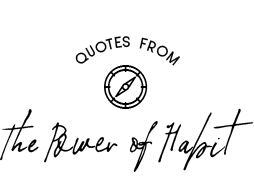Whether it’s to exercise more consistently, quit smoking, monitor shopping habits, thanks to science, we know more about how our routines and habits form. Scientists at MIT discovered that cravings are part of a neurological loop. It starts with a cue, routine, and reward.
The Habit Neurological Loop
- CUE: It’s Friday afternoon and you’re working on your computer.
- ROUTINE: You visit your go-to online stores and you buy something.
- REWARD: You feel excitement thinking of when you’ll get the package.
The loop is fueled by a CRAVING for the reward.

“When a habit emerges, the brain stops fully functioning in decision making.”
Charles Duhigg | The Power of Habit
The loop provides a framework for us to understand habits, how they form, and how to use this knowledge for self-improvement. It’s not a one-size fits all concept. Rather, it involves a process of self-exploration. There’s work and analysis involved, so wanting to make a change is critical. The good news is, the process of mapping out our actions to better understand why we do the things we do is exciting. You’re getting to know, you!
Mantra
“I”m getting a PhD in (your name).”
Change a Habit | Form New Ones
“…you can never truly extinguish bad habits. Rather, to change a habit, you must keep the old cue, and deliver the old reward, but insert a new routine.”
Charles Duhigg | The Power of Habit
Step 1
Figuring out the loop is the first step to analyzing habits. You know the routine you want to alter, so the effort goes into figuring out the cue and the reward. These might not be as straightforward as you think.
Take our Friday afternoon shopping example. Is it Friday that’s the cue? Maybe a particular task you work on during that time? Is it boredom?
Step 2
Charles Duhigg notes that the second step is to experiment with rewards. This involves changing the routine.
In our example, instead of visiting online stores, trying standing up and going for a walk, stretching, watch a music video, or chat with a friend when you feel the urge shop online. The point is to change it up every week. This might take a few attempts. What you’re doing is identifying the craving that is responsible for the routine. Are you craving a mental break from what you’re doing? Do you just need to distract yourself from the task? Do you want to be entertained? Do you want to feel pampered? Get a sense of excitement?
After you completed the routine for that week, jot down the first 3 things that come to mind. These can be anything! Continue with what you had to do and then after 15 minutes, assess if you still have the urge to shop online.
According to Duhigg, assessing if the alternative routine has or hasn’t eliminated the craving (in this case, to buy something), helps you determine what exactly shopping gives you as a reward.
Step 3
The 3rd step is to isolate the cue. You know it’s Friday and you’re on a computer working, but what exactly is happening? Duhigg recommend jotting down: location, time, emotional state, other people with you, what you were doing when the thought of opening up a browser and shopping occurred. While experimenting with the routine, write down details about the cue in order to isolate it.
Step 4
Once you understand the loop, you can have a plan to change the routine. So if you realize that you get this urge on a Friday afternoon because you’re bored and craving excitement, instead of shopping and spending money, what can you replace shopping with, an activity that is benefits your life.

On Eating Habits
“But habits emerge without our permission. Studies indicate that families usually don’t intend to eat fast food on a regular basis. What happens is that a once a month pattern slowly becomes once a week, and then twice a week—as the cues and rewards create a habit—until the kids are consuming an unhealthy amount of hamburgers and fries.
On Working Out
In one group, 92 percent of people said they habitually exercised because it made them “feel good”—they grew to expect and crave the endorphins and other neurochemicals a workout provided. In another group, 67 percent of people said that working out gave them a sense of “accomplishment”—they had come to crave a regular sense of triumph from tracking their performances, and that self-reward was enough to make the physical activity into a habit.
“…think about that smoothie, or about the endorphin rush you’ll feel. Allow yourself to anticipate the reward. Eventually, that craving will make it easier to push through the gym doors every day.
On Running
If you want to start running each morning, it’s essential that you choose a simple cue (like always lacing up your sneakers before breakfast or leaving your running clothes next to your bed) and a clear reward (such as a midday treat, a sense of accomplishment from recording your miles, or the endorphin rush you get from a jog).
Only when your brain starts expecting the reward—craving the endorphins or sense of accomplishment—will it become automatic to lace up your jogging shoes each morning. The cue, in addition to triggering a routine, must also trigger a craving for the reward to come.
